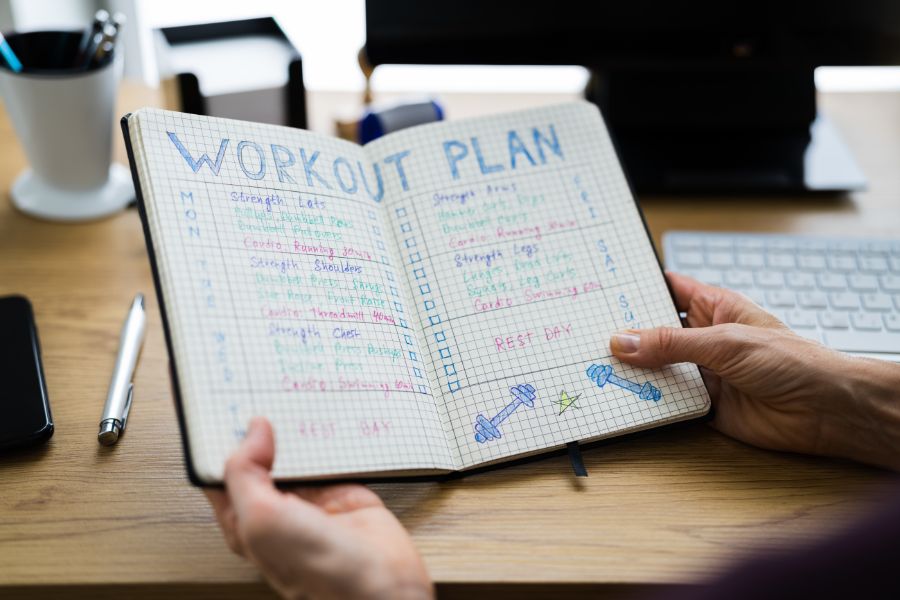Your mental health affects every aspect of your life in more ways than one, and poor mental health makes you vulnerable to some illnesses and health issues. Fortunately, fitness and protein supplements have been shown to help mental health in many aspects.
How does fitness help mental health? We’ll answer this question and more in this article.
So, let’s get started.
What Are the Benefits of Exercise on Mental Health?
Other Health Benefits of Exercise
How to Overcome Difficulties to Exercising
Starting Exercising When You Have a Mental Issue
How to Start a Physical Exercise Plan
Other Ways to Exercise Without Visiting the Gym
Exercising Is Easier Than You Think
What Is Mental Health
Mental health refers to our emotional, psychological, and social well-being. It’s all about how we think, feel, behave, and interact with the world around us. In addition, good mental health means coping with life’s challenges, maintaining positive relationships with others, and feeling a sense of purpose and meaning in our daily lives.
Why is mental health so important? Because it affects every aspect of our lives. Poor mental health can lead to various problems ranging from anxiety to depression, stress, and physical health issues.
It can also impact our relationships, work, and ability to enjoy life. Plus, it boosts happy feelings, resilience, and a better ability to cope with life’s ups and downs.

What Are the Benefits of Exercise on Mental Health?
Exercise has physical benefits and just as much impact on our mental well-being. Physical activities are one of the most effective ways to improve mental health.
Why is that? Due to the following reasons:
Reduces Stress and Anxiety
Exercise is a natural stress-buster. It releases endorphins, chemicals that make us feel good. These endorphins are natural painkillers and mood elevators. They help us feel happier and more relaxed. Additionally, physical activity limits stress hormones in your body, decreasing anxiety and overall calmness.
Improves Self-esteem
When you exercise regularly, you’ll feel better about your body, leading to increased confidence and a more positive self-image.
Feeling good about yourself makes you more likely to take care of your mental health. In addition, you’ll feel inspired to engage in healthy habits like eating well and getting enough sleep.
Combats Depression
Studies have found that people who engage in regular physical activity are less likely to experience symptoms of depression than those who don’t. Why? Because exercise increases serotonin and dopamine neurotransmitters in the brain. These neurotransmitters are associated with happiness and well-being.
Enhances Cognitive Function
Furthermore, physical activity strengthens blood flow to the brain, enhancing memory and concentration.
Additionally, exercise stimulates the growth of new brain cells, leading to improved brain function over time.
Promotes Better Sleep
Exercise also boosts the quality and duration of sleep. Since sleeping is vital for good mental health, physical activities allow our brains and bodies to rest and recharge.
Boosts Mood
Regular exercise fosters a positive mood as well. Even a short workout can help lift our mood and leave us feeling more energized and motivated.
Therefore, it’s safe to say exercise reduces mental health conditions symptoms like depression.
Types of Physical Exercise
Here are some of the most popular types of physical activity:
Aerobic Exercise
Aerobic exercise, also known as cardio, is any activity that increases your heart and breathing rates. This exercise boosts cardiovascular health, endurance, and stamina.
Aerobic exercise includes running, cycling, swimming, dancing, and brisk walking.
Strength Training
Popularly known as resistance training, strength training is any exercise that involves using weights or other forms of resistance to build muscle strength and endurance.
It’s vital for maintaining bone density, preventing injury, and enhancing overall body composition. Examples of strength training exercises include weightlifting, push-ups, squats, and lunges.
Flexibility Training
Flexibility training, or stretching, is any exercise that heightens the range of motion and mobility of your joints and muscles.
Stretching moderates physical activity, prevents injury, improves posture, and reduces muscle tension. Examples of flexibility training exercises include yoga, pilates, and static stretching.
High-Intensity Interval Training (HIIT)
HIIT is a type of workout that involves short bursts of high-intensity exercise followed by periods of rest or lower-intensity exercise.
HIIT aims to strengthen cardiovascular health, burn calories, and build endurance. Sprints, jump squats, and burpees are all examples of HIIT.
Low-Impact Exercise
Low-impact exercise is any form of exercise that is gentle on the joints and does not involve high-impact movements. This type of exercise is ideal for people with injuries, chronic pain, or mobility issues.
Other Health Benefits of Exercise
Improves Immune Function
Regular exercise boosts your immune system, making it easier for your body to fight infections and diseases.
This is because exercise increases the production of antibodies and white blood cells, both essential for a healthy immune system.
Reduces Inflammation
Inflammation is the body’s natural response to injury or infection. However, chronic inflammation can cause various health problems like heart disease, diabetes, and arthritis. Luckily, you can avoid this by exercising.
Strengthens Bones and Muscles
Physical activities enable you to maintain healthy bones and muscles. For example, regular weight-bearing exercises like running or weightlifting increase bone density and reduce osteoporosis risk.
Strength training exercises also build and maintain muscle mass, which is vital for overall health and mobility.
Improves Digestive Health
Exercise also benefits your digestive health by increasing blood flow to the gut and stimulating the digestive tract muscles.
This singular action may reduce digestive disorder symptoms like constipation and irritable bowel syndrome (IBS).
Boosts Brain Function
Additionally, physical activities have numerous benefits for the brain. It can improve cognitive function, memory, and attention span.
Regular exercise was also linked to a reduced risk of cognitive decline and dementia in later life.
Promotes Better Sleep
Finally, it promotes better sleep by reducing stress and anxiety. This is possible because exercise increases the production of sleep-promoting hormones and regulates the body’s circadian rhythm.
Better sleep, in turn, improves overall health and well-being.
How to Overcome Difficulties to Exercising

Starting an exercise program can be challenging, even more so when facing difficulties that make it hard to create.
But don’t give up just yet – with some planning and effort, you can overcome these obstacles and reach a healthier, happier you. Here are some tips on how to overcome difficulties in exercising:
Lack of Motivation
You need motivation to stick to an exercise class. If you lack motivation, try setting realistic goals and rewarding yourself when you achieve them.
Joining a fitness class or finding a workout buddy can keep you accountable and motivated.
Lack of Time
With busy schedules and responsibilities, finding time to exercise can be challenging. However, even small amounts of exercise can make a difference.
Try breaking up your workout into shorter sessions throughout the day or exercising during your lunch break or before work.
Physical Limitations
Finding an exercise routine that works may seem impossible if you have physical limitations. However, many options include chair exercises, water aerobics, low-impact yoga, and tai chi.
Don’t hesitate to consult a mental health professional or physical therapist for guidance.
Lack of Confidence
If you’re self-conscious or embarrassed about exercising, try starting with at-home workouts or using workout apps to build your confidence. Then, gradually work up to exercising in a public gym or fitness class.
Financial Constraints
Gym memberships and fitness equipment can be costly, but many free or low-cost options are available. For example, you can opt for an outdoor option, community fitness programs, or household items like workout equipment.
Weather Conditions
Extreme weather conditions can make it difficult to exercise outdoors. So, you may explore indoor workouts such as yoga or dance or invest in home exercise equipment.
Starting Exercising When You Have a Mental Issue
Consult With a Healthcare Provider
Before starting any exercise routine, it’s essential to consult with a healthcare provider, more so if you have pre-existing mental health problems.
Your provider can help you determine the best type and amount of exercise for your specific needs and limitations.
Start Slowly
Starting an exercise routine can be overwhelming, especially when dealing with mental health issues.
Start slowly and gradually increase the intensity and duration of your workouts as you feel comfortable. Remember, any movement is better than none, so even short walks or gentle stretching can be beneficial.
Find an Exercise That You Enjoy
Exercise doesn’t have to be boring or unpleasant. Instead, find an activity you enjoy, such as dancing, hiking, or swimming, and make it a regular part of your routine. This will help you stay motivated and make exercise less like a chore.
Incorporate Mindfulness Practices
Mindfulness practices, like yoga or meditation, significantly enhance exercise’s mental health benefits. These practices may reduce stress, improve focus, and increase feelings of calm and relaxation.
Use Exercise as a Coping Mechanism
Exercise can be a healthy coping mechanism for stress, anxiety, and depression. Instead of turning to unhealthy coping mechanisms like overeating or substance abuse, try exercising to manage your emotions and improve your mental health.
Don’t Be Too Hard on Yourself
Starting an exercise routine can be challenging, and being kind is essential. Don’t set unrealistic expectations or beat yourself up if you miss a workout.
Remember, the goal is to improve your mental health and well-being, and any progress is worth celebrating.
How to Start a Physical Exercise Plan

Set Your Goals
Before you start any exercise plan, first define your goals. For example, do you want to lose weight, build muscle, improve your endurance, or feel healthier? Setting specific goals will help you stay motivated and track your progress.
Choose Your Activities
Once you know your goals, you can choose the activities to help you achieve them. If you’re new to exercise, start with low-impact activities like walking, swimming, or cycling.
As you become more comfortable, you can try more challenging workouts like weightlifting or high-intensity interval training (HIIT).
Schedule Your Workouts
Plan when and how often you’ll work out. This could be as simple as scheduling a daily 20-minute walk or setting aside time for a weekly yoga class. But, again, consistency is vital, so choose and stick to a schedule that works for you.
Start Slowly
It’s necessary to start slowly and gradually increase the intensity of your workouts. This will help you avoid injury and prevent burnout.
If you’re new to exercise, start with just a few minutes of activity each day and gradually increase your time and intensity over several weeks.
Track Your Progress
Keeping track of your progress boosts your motivation and allows you to celebrate your successes.
Try using a fitness app, a journal, or a simple spreadsheet to track your workouts, weight, and other metrics.
Get Support
Don’t hesitate to ask for help or support. It could mean finding a workout buddy, hiring a personal trainer, or joining a fitness class.
Having someone to hold you accountable and cheer you on can make all the difference in sticking to your exercise plan.
Other Ways to Exercise Without Visiting the Gym
Going to the gym is not the only way to stay active and fit. There are plenty of ways to exercise without stepping foot in a gym.
Moderate-intensity exercise can make a positive difference in your mental health. You can try out these alternatives to the gym:
- Outdoor Activities: Outdoor activities like hiking, biking, or swimming are great ways to get exercise and enjoy the great outdoors at the same time. Not only are these activities fun, but they also provide a change of scenery and fresh air.
- At-Home Workouts: At-home workouts are an excellent option for those who prefer exercising at home. Many workout apps and YouTube channels offer free at-home workouts, from yoga to high-intensity interval training (HIIT).
- Walking or Running: This is a simple, effective way to exercise. All you need is a good pair of shoes, and you’re ready to go. You can walk or run around your neighborhood or find local trails or parks to explore.
- Dancing: Dancing is a fun, energetic way to get your heart rate up and improve your coordination. So, take a dance class, follow along with a dance workout video, or dance around your living room.
- Household Chores: Believe it or not, household chores may provide a workout. Vacuuming, mopping, or gardening can burn calories and increase your heart rate.
- Active Commuting: If you live near your workplace or school, consider biking or walking instead of driving. This provides a great workout and reduces your carbon footprint.
Exercising Is Easier Than You Think
Many people believe that exercise is difficult, time-consuming, and requires a lot of equipment or gym memberships. However, the truth is that exercising is easier than you think. Here are some reasons why:
- You Can Start Small: You don’t have to run a marathon or lift heavy weights to start exercising.
You can start with small, achievable goals like taking a 10-minute walk or stretching daily. Then, gradually increase the duration and intensity of your workouts as you feel comfortable. - You Can Fit Exercise Into Your Daily Routine: Exercise doesn’t have to be a particular activity you need to make time for. Instead, you can incorporate it into your daily routine by taking the stairs instead of the elevator, walking or biking to work, or doing squats while you brush your teeth.
- You Don’t Need Equipment: While gym equipment can be helpful, you don’t need it to get a good workout.
Bodyweight exercises, such as push-ups, squats, and lunges, can be done anywhere and require no equipment. Resistance bands and dumbbells are also affordable and portable options. - You Can Find Activities You Enjoy: Exercise shouldn’t be boring or unpleasant. Find an activity you enjoy, like dancing, hiking, or swimming, and make it a regular part of your routine. This will help you stay motivated and make exercise less like a chore.
Summary
Fitness plays a crucial role in maintaining good mental health. That’s because it limits the symptoms of anxiety, depression, and stress. In the long run, it improves mood and overall quality of life.
Overall, the benefits of fitness on mental health are clear, and it’s never too late to start incorporating it into your routine. Whether you prefer to hit the gym, run, or try something new like yoga or dancing, find an activity you enjoy and make it a regular part of your life!




